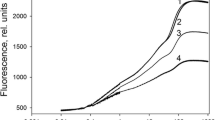Abstract
A barley mutant RPr84/90 has been isolated by selecting for plants which grow poorly in natural air, but normally in air enriched to 0.8% CO2. After 5 minutes of photosynthesis in air containing14CO2 this mutant incorporated 26% of the14C carbon into phosphoglycollate, a compound not normally labelled in wild type (cv. Maris Mink) leaves.
The activity of phosphoglycollate phosphatase (EC 3.1.1.18) was 1.2 nkat mg−1 protein at 30°C in RPr 84/90 compared to 19.2 nkat mg−1 protein in the wild-type leaves. Phosphoglycollate phosphatase activity was not detected after protein separation by electrophoresis of leaf extracts from the mutant on polyacrylamide gels; on linear 5% acrylamide gels three bands with enzyme activity were separated from extracts of wild type plants. Gradient gel electrophoresis followed by activity staining showed two bands in Maris Mink tracks of MW 86,000 and 96,000, but no bands in 84/90. This is the first report of isozymes of phosphoglycollate phosphatase in barley which were absent in the mutant extracts. Our results confirm an earlier report of isozymes of this phosphatase in Phaseolus vulgaris [18].
The photosynthetic rate of RPr 84/90 in 1% O2, 350 μl CO2 l−1 was 9–12 mg CO2 dm−2 h−1 at 20°C, whereas the wild-type rate was 27–29 mg CO2 dm−2 h−1 at 20°C. In 21% O2, 350 μl CO2 l−1 the rate was 2–3 mg CO2 dm−2 h−1 in the mutant and 20 mg CO2 dm−2 h−1 in the wild type.
Genetic analysis has shown that the mutation segregates as a single recessive nuclear gene.
Similar content being viewed by others
References
Anderson DE and Tolbert NE (1966) Phosphoglycollate phosphatase. In: Colowick SP and Kaplan NO (eds) Methods in Enzymology, Vol. IX. pp 646–647. New York, London: Academic Press
Anderson LE (1971) Chloroplast and cytoplasmic enzymes. II Pea leaf triose phosphate isomerases. Biochim Biophys Acta 235:237–244.
Boyle FA and Keys AJ (1982) Regulation of RuBP carboxylase activity associated with photoinhibition of wheat. Photosynth Res 3:105–111
Bradford M (1976) A rapid and sensitive method for the quantitation of microgram quantities of protein utilizing the principle of protein dye binding. Anal Biochem 72:248–254
Christeller JT and Tolbert NE (1978) Phosphoglycollate phosphatase. J Biol Chem 253:1780–1785
Hall NP, Reggiani R and Lea PJ (1985) Molecular weights of glycollate oxidase from C3 and C4 plants determined during early stages of purification. Phytochem 24:1645–1648
Hurst RO (1964) The determination of nucleotide phosphorus with a stannous chloride-hydrazine sulphate reagent. Can J Biochem 42:287–292
Kendall AC, Keys AJ, Turner JC, Lea PJ and Miflin BJ (1983) The isolation and characterisation of a catalase-deficient mutant of barley (Hordeum vulgare L.). Planta 159:505–511
Kendall AC, Hall NP, Keys AJ, Lea PJ, Turner JC and Wallsgrove RM (1985) Carbon and nitrogen metabolism in photorespiratory mutants of barley (Hordeum vulgare L.). In: Marcell R et al., (ed) Biological control of photosynthesis, pp 257–265. The Hague: Junk
Kendall AC, Turner JC, Bird IF, Driscoll SP, Cornelius MJ and Keys AJ Separation of14C-labelled products of photosynthesis by thin-layer cellulose powder chromatography in two dimensions: quantitation of radioactivity. Photosynth Res (in press)
Kerr MW and Gear CF (1974) Studies of phosphoglycollate phosphatase isolated from pea leaves. Biochem Soc Trans 2:338–340
Chollet R and Ogren WL (1975) Regulation of photorespiration in C3 and C4 plants. Bot Rev 41:137–179
Margolis J and Wrigley CW (1975) Improvement of pore gradient electrophoresis by increasing the degree of cross-linking at high acrylamide concentrations. J Chromatog 106:204–209
Ogren WL (1984) Photorespiration: pathways, regulation and modification. Ann Rev Plant Physiol 35:415–42
Richardson KE and Tolbert NE (1961) Phosphoglycolic acid phosphatase. J Biol Chem 236:1285–1290
Somerville CR and Ogren WL (1979) A phosphoglycollate phosphatase deficient mutant of Arabidopsis. Nature 280:833–836
Sommerville CR and Ogren WL (1982) Genetic modification of photorespiration. TIBS 1:171–4
Verin-Vergeau C, Baldy P and Cavalie G (1979) La phosphoglycollate phosphatase des feuilles de haricot: deux formes isofonctionnelles. Phytochem 18:1279–1282
Whittingham CP (1981) Photosynthesis, photorespiration and crop productivity. In: Akoyunoglou G (ed) Photosynthesis, Vol. 6, pp 3–10. Philadelphia: Balaban International Science Services
Wolfenden R (1969) Transition state analogues for enzyme catalysis. Nature 223: 704–705
Author information
Authors and Affiliations
Rights and permissions
About this article
Cite this article
Hall, N.P., Kendall, A.C., Lea, P.J. et al. Characteristics of a photorespiratory mutant of barley (Hordeum vulgare L.) deficient in phosphogly collate phosphatase. Photosynth Res 11, 89–96 (1987). https://doi.org/10.1007/BF00117676
Received:
Revised:
Issue Date:
DOI: https://doi.org/10.1007/BF00117676




